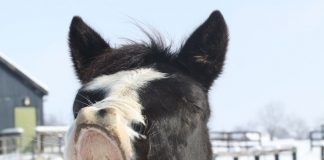 If you own horses long enough, sooner or later you are likely to confront a medical emergency. From lacerations to colic to foaling difficulties, there are many emergencies that a horse owner may encounter. It’s important to know how to recognize serious problems and respond promptly.
If you own horses long enough, sooner or later you are likely to confront a medical emergency. From lacerations to colic to foaling difficulties, there are many emergencies that a horse owner may encounter. It’s important to know how to recognize serious problems and respond promptly.
1. Keep your veterinarian’s number by each phone, including how he or she can be reached after hours.
2. Consult with your regular veterinarian regarding a backup or referring veterinarian’s number in case you cannot reach your regular veterinarian quickly enough.
3. Know in advance the most direct route to an equine surgery center in case you need to transport the horse.
4. Post the names and phone numbers of nearby friends and neighbors who can assist you in an emergency while you wait for the veterinarian.
5. Prepare a first aid kit and store it in a clean, dry, readily accessible place. Make sure that family members and other barn users know where the kit is. Also, keep a first aid kit in your horse trailer or towing vehicle and a smaller version to carry on the trail.
First aid kits can be simple or elaborate. Here is a short list of essential items:
• Cotton roll
• Wrapping materials
• Gauze pads in assorted sizes
• Sharp scissors
• Cup or container
• Rectal thermometer with string and clip attached
• Surgical scrub and antiseptic solution
• Latex gloves
• Saline solution
• Stethoscope
• Clippers
Many accidents can be prevented by taking the time to evaluate your horse’s environment and removing potential hazards. In an emergency, time is critical. Don’t be concerned with overreacting or annoying your veterinarian. By acting quickly and promptly, you can minimize the consequences of an injury or illness.
For more information, ask your equine veterinarian for the “Emergency Care” brochure provided by the AAEP in partnership with Educational Partner Bayer Animal Health. More information also can be obtained by visiting the AAEP’s horse health web site, www.MyHorseMatters.com.






Excellant artical. Most useful information.
great article
I also carry first aid essentials in a saddle bag even for short trail rides. Hoof pick, wire cutters, small pruning clippers, vet wrap, gauze pads, alcohol wipes & very small bottle of betadine & some water. I never go out without my cell phone and if I’m riding alone I try to let someone know which direction I’m headed just in case I’m gone too long or Kacey comes back without me. Fortunately, I’ve never had to use any of it (except the clippers to do some trail clearing), but I would rather be safe than sorry.
I take te first aid kit to all my shows and it helps me and my friends feel safer
This is important-and sadly often neglected-information. Thanks, HC!
Thanks for the list of supplies included in a first aid kit, it’s much appreciated. Briana